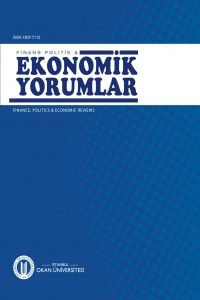Kredi Portföy KalitesininBelirleyicileri ve Makro-FinansalBağlantıların Rolü
Çalışmada ticari bankaların kredi portföylerinin kalitesi analiz edilmekte, kredi kalitesini belirleyen değişkenler araştırılmaktadır. Türkiye’de faaliyet gösteren 27 ticari bankanın 2004-2014 dönemi verileri dinamik panel veri modelleriyle analiz edilmiştir. Analizlerde Arellano-Bond ve ABBB gibi alternatif tahminciler kullanılmıştır. Elde edilen bulgular, banka kredilerinin kalitesinin makro-finansal değişkenler kadar, sektördeki rekabet ve banka temelli değişkenlerin de fonksiyonu olduğunu göstermektedir. Ekonomik ve finansal şokların kredi kalitesini düşürerek banka sistemini zaafa uğratacak kırılganlıklara yol açabileceği belirlenmiştir. Eksik rekabet koşullarının geçerli olduğu sektörde kamu bankaları ve yabancı bankaların kredi kalitesini geliştirdikleri gözlenmiştir. Kredileri ve/veya karlılığı yönlendiren banka temelli değişkenlerin de kredi kalitesini önemli oranda etkiledikleri görülmüştür.
Anahtar Kelimeler:
Ticari bankacılık, kredi kalitesi, makro-finansal bağlar, dinamik panel veri modelleri
The Determinants of Loan Portfolio Quality and the Role of Macro-Financial Linkages
In this study, loan portfolio quality of commercial banks and the variables determining the credit quality are studied. The data of 27 commercial banks operating in Turkey during 2004-2014 period have been analyzed by dynamic panel data models. Alternative estimators such as Arellano-Bond and ABBB are used in the analysis. The findings show that bank loan quality is function of both the competition in banking sector and the individual factors as well as macro-financial linkages. We have determined that economic and financial shocks can lead to fragilities weakening the banking system by reducing the quality of the loans. In the banking sector where we have conditions of imperfect competition, we have observed that state banks and foreign banks improve the loan quality. Also we have that bank based variables driving loans and/or profitability affect significantly the quality of loans
___
- ARELLANO, Manuel and Stephen BOND; (1991), “Some Tests of Specification for Panel Data: Monte Carlo Evidence and an Application to Employment Equations,” Review of Economic Studies, 58(2), pp. 277–297.
- ARELLANO, Manuel and Olympia BOVER; (1995), “Another Look at the Instrumental Variable Estimation of Error Component Models,” Journal of Econometrics, 68(1), pp. 29-51.
- BELLEGO, C. and L. FERRARA; (2012), “Macro-Financial Linkages and Business Cycles: A Factor Augmented Probit Approach”, Economic Modelling, 29(5), pp. 1793-1797.
- BOUVATIER, Vincent, Antonia LOPEZ-VILLAVICENCIO, and Valeri MIGNON; (2012), “Does the Banking Sector Structure Matter for Credit Procyclicality?”, Economic Modelling, 29(4), pp. 1035-1044.
- BÖNINGHAUSEN, Benjamin, and Matthias KÖHLER; (2015), “Diversification and Determinants of International Credit Portfolios: Evidence from German Banks”, International Review of Economics and Finance, 39(1), pp. 57-75.
- BLUNDELL, Richard and Stephen BOND; (1998), “Initial Conditions and Moment Restrictions in Dynamic Panel Data Models,” Journal of Econometrics, 87(1), pp. 115-143.
- CHOI, In; (2001), “Unit Root Tests for Panel Data”, Journal of International Money and Finance, 20(2), pp. 249–272.
- De HAAS, Ralph, Daniel FERREIRA, and Anita TACI; (2010), “What Determines the Composition of Banks’ Loan Portfolios? Evidence from Transition Countries”, Journal of Banking and Finance, 34, pp. 388-398.
- FILIP, Bogdan F.; (2015), “The Quality of Bank Loans within the Framework of Globalization”, Procedia – Economics and Finance, 20, pp. 208-217.
- GERKE, R., M. JONSSON, M. KLIEM, M. KOLASA, P. LAFOURCADE, A. LOCARNO, , K. MAKARSKI and P. McADAM; (2013), “Assessing Macro-financial Linkages: A Model Comparison Exercise”, Economic Modelling, 31, pp. 253-264.
- IM, Kyung So, M. Hashem PESARAN and Yongcheol SHIN; (2003), “Testing for Unit Roots in Heterogeneous Panels”, Journal of Econometrics, 115(1), pp. 53-74.
- KUPIEC, Paul H. and Carlos D. RAMIREZ; (2013), “Bank Failures and the Cost of Systemic Risk: Evidence from 1900 to 1930”, Journal of Financial Intermediation, 22(3), pp. 285-307.
- LAMA, Ruy, and Pau RABANAL; (2014), “Deciding to Enter a Monetary Union: The Role of Trade and Financial Linkages”, European Economic Review, 72, pp. 138-165.
- LEVIN, Andrew, Chien-Fu LIN and C. James CHU; (2002), “Unit Root Tests in Panel Data: Asymptotic and Finite-Sample Properties”, Journal of Econometrics, 108(1), pp. 1-24.
- LOVE, Inessa, and Rima T. ARISS; (2013), “Macro-financial Linkages in Egypt: A Panel Analysis of Economic Shocks and Loan Portfolio Quality”, IMF Working Paper, No: WP/12/271.
- LOVE, Inessa, and Rima T. ARISS; (2014), “Macro-financial Linkages in Egypt: A Panel Analysis of Economic Shocks and Loan Portfolio Quality”, Journal of International Financial Markets, Institutions and Money, 28, pp. 158-181.
- ONYIRIUBA, Leo; (2016), “Bank Credit Portfolio Structure, Quality, and Returns in Emerging Economies”, Chapter 38, Leo ONYIRIUBA (Ed.), Emerging Market Bank Lending and Credit Risk Control, Academic Press, London, pp. 671-689.
- Roodman, David; (2006), “How to Do xtabond2: An Introduction to “Difference” and “System” GMM in Stata”, Center for Global Development Working Paper, No:103, December.
- Roodman, David; (2008), “A Note on the Theme of Too Many Instruments”, Center for Global Development Working Paper, No: 125, May.
- SUN, Tao; (2010), “Identifiyng Vulnerabilities in Systemically Important Financial Institutions in a Macro-Financial Linkages Framework”, Journal of Economic Asymmetries, 7(2), pp. 77- 103.
- SWAMY, Vighneswara; (2013), “Banking System Resilience and Financial Stability – An Evidence from Indian Banking”, Journal of International Business and Economy, 14(1), pp. 87- 117.
- TATOĞLU, Ferda Y.; (2013), İleri Panel Veri Analizi: Stata Uygulamalı, İstanbul, Beta Yayınevi.
- ISSN: 1307-7112
- Başlangıç: 1963
- Yayıncı: İstanbul Okan Üniversitesi
